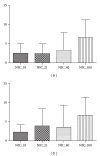Reoxygenation of asphyxiated newborn piglets: administration of 100% oxygen causes significantly higher apoptosis in cortical neurons, as compared to 21%
- PMID: 24783208
- PMCID: PMC3982623
- DOI: 10.1155/2014/476349
Reoxygenation of asphyxiated newborn piglets: administration of 100% oxygen causes significantly higher apoptosis in cortical neurons, as compared to 21%
Abstract
Objective: Evaluation of neuronal changes in an animal experimental model of normocapnic hypoxia- reoxygenation.
Materials and methods: Fifty male piglets were the study subjects; normocapnic hypoxia was induced in 40 piglets and ten were sham-operated (controls). When bradycardia and/or severe hypotension occurred, reoxygenation was initiated. Animals were allocated in 4 groups according to the oxygen concentration, they were resuscitated with 18%, 21%, 40%, and 100% O2. Persisting asystole despite 10 minutes of cardiopulmonary resuscitation and return of spontaneous circulation were the endpoints of the experiment. Surviving animals were euthanized and brain cortex samples were collected, hematoxylin and eosin-stained, and examined for apoptotic bodies observing 10 consecutive high power fields.
Results: Histological examination of the control group did not show any pathological change. On the contrary, apoptosis of neurons was found in 87.5% of treated animals. When specimens were examined according to the oxygen concentration used for resuscitation, we found marked intergroup variability; a higher percentage of apoptotic neurons was observed in piglets of group 4 (100% oxygen) compared to the others (P=0.001).
Conclusions: This preliminary data shows that normocapnic hypoxia and reoxygenation in Landrace/Large White piglets resulted in significant histological changes in the brain cortex. The degree of pathological changes in cortical neurons was significantly associated with the oxygen concentration used for reoxygenation, with a higher percentage of apoptotic neurons being observed in piglets reoxygenated with 100% compared to 18% O2 and to 21% O2.
Figures





Similar articles
-
Impaired early neurologic outcome in newborn piglets reoxygenated with 100% oxygen compared with room air after pneumothorax-induced asphyxia.Pediatr Res. 2001 Jun;49(6):812-9. doi: 10.1203/00006450-200106000-00017. Pediatr Res. 2001. PMID: 11385143
-
S100B immunoreactivity: a new marker of hypoxia-related cardiac damage in newborn piglets.J Matern Fetal Neonatal Med. 2013 Oct;26 Suppl 2:72-6. doi: 10.3109/14767058.2013.830410. J Matern Fetal Neonatal Med. 2013. PMID: 24059558
-
A dose-response study of graded reoxygenation on the carotid haemodynamics, matrix metalloproteinase-2 activities and amino acid concentrations in the brain of asphyxiated newborn piglets.Resuscitation. 2006 May;69(2):319-27. doi: 10.1016/j.resuscitation.2005.08.012. Epub 2006 Feb 24. Resuscitation. 2006. PMID: 16500017
-
Hypoxia - Reoxygenation in neonatal cardiac arrest: Results from experimental models.Semin Fetal Neonatal Med. 2020 Apr;25(2):101085. doi: 10.1016/j.siny.2020.101085. Epub 2020 Jan 16. Semin Fetal Neonatal Med. 2020. PMID: 32014367 Review.
-
Room air or 100% oxygen for resuscitation of infants with perinatal depression.Curr Opin Pediatr. 2009 Apr;21(2):188-93. doi: 10.1097/MOP.0b013e32832925b8. Curr Opin Pediatr. 2009. PMID: 19300260 Review.
Cited by
-
Hyperoxygenation With Cardiopulmonary Resuscitation and Targeted Temperature Management Improves Post-Cardiac Arrest Outcomes in Rats.J Am Heart Assoc. 2020 Oct 20;9(19):e016730. doi: 10.1161/JAHA.120.016730. Epub 2020 Sep 23. J Am Heart Assoc. 2020. PMID: 32964774 Free PMC article.
References
-
- Delivoria-Papadopoulos M, Ashraf QM, Mishra OP. Differential expression of apoptotic proteins following hypoxia-induced CREB phosphorylation in the cerebral cortex of newborn piglets. Neurochemical Research. 2007;32(7):1256–1263. - PubMed
-
- Allende-Castro C, Espina-Marchant P, Bustamante D, et al. Further studies on the hypothesis of PARP-1 inhibition as a strategy for lessening the long-term effects produced by perinatal asphyxia: effects of nicotinamide and theophylline on PARP-1 activity in brain and peripheral tissue—nicotinamide and theophylline on PARP-1 activity. Neurotoxicity Research. 2012;22(1):79–90. - PubMed
-
- Solas AB, Kutzsche S, Vinje M, Saugstad OD. Cerebral hypoxemia-ischemia and reoxygenation with 21% or 100% oxygen in newborn piglets: effects on extracellular levels of excitatory amino acids and microcirculation. Pediatric Critical Care Medicine. 2001;2(4):340–345. - PubMed
Publication types
MeSH terms
Substances
LinkOut - more resources
Full Text Sources
Other Literature Sources
Medical

